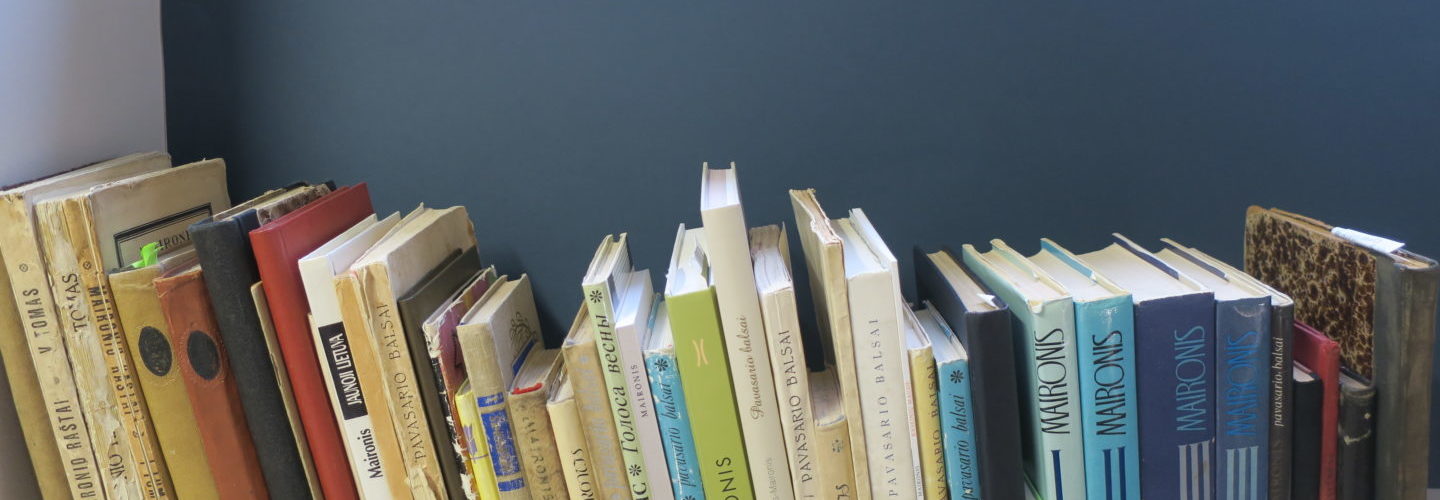
The most creative period for Jonas Mačiulis Maironis was the time spent studying at St. Petersburg Spiritual Academy (1888-1892) and lecturing at Kaunas Theology Seminary. Some J. Mačiulis’ poems were composed during his last months of the seminary, and he started his poem ‘Tarp skausmų į garbę’ (Through Grief to Glory) then. In 1994, the priest was appointed to work as a professor of St. Petersburg Spiritual Academy. During these significant years of Maironis’ creative oeuvre, the poem ‘Tarp skausmų į garbę’ (Through Grief to Glory) was published under the pseudonym St. Garnys, and ‘Pavasario balsai’ (The Voices of Spring), a collection of his poems, worked up while living still in Kaunas, was released. In 1904, the poem created still at the end of the 19th century and written in Polish ‘Z nad Biruty’ was issued. The new edition of ‘Pavasario balsai’ (The Voices of Spring) released in 1905 included some newly composed poems. In 1907, Maironis’ poetic composition ‘Jaunoji Lietuva’ (The Young Lithuania), altered and renamed from an earlier version of the poem ‘Tarp skausmų į garbę’, was published. In 1909, Maironis returned to Kaunas after being invited to take the rector’s position at Kaunas Theology Seminary. The poem ‘Raseinių Magdė’ (Magde of Raseiniai), issued in Kaunas in 1909, was a satirical poem meant for the Polish Nobility in Lithuania. In 1920 Maironis’ poem ‘Mūsų vargai’ (Our Hardships) was published. It resembled more a cultural and political chronicle of a period than purely a work of art. The poem was written during the First World War when Kaunas Theology Seminary and Maironis as its rector moved to Vašuokėnai estate, and when the seminary was closed, the poet dwelt and worked in Krekenava. The third decade of the 20th century inspired Maironis to write a number of historical verses and poems. He wrote the dramatic trilogy ‘Kęstučio mirtis’ (The Death of Kestutis) in 1921, ‘Vytautas pas kryžiuočius’ (Vytautas in Captivity of Crusaders) in 1925, and ‘Vytautas – Karalius’ (Vytautas becomes the King) in 1928. The trilogy was composed as a tribute to Vytautas the Great, and the tragic side of the Lithuanian history. In 1926, Maironis revised, supplemented, prepared for publication, and financed five volumes of ‘Raštai’ (Collected Works by Maironis) that included most of the poet’s creative oeuvre.
When Maironis was still alive, the poet’s main, one and only collection of his poems ‘Pavasario balsai’ (The Voices of Spring) was issued five times. The editions in 1895, 1905, 1913, and 1920 were published as separate books, but in 1927, the fifth publication of the collection was included in the first volume of ‘Raštai’ (Collected Works by Maironis). All the editions were significantly different as each of them was revised, supplemented with new pieces of poetry, some poems were rephrased and their composition was altered. Each edition of Maironis’ ‘Pavasario balsai’ is like an original story unveiling peculiar stages of the poet’s life.
In 1894 Jonas Mačiulis Maironis arrived in Switzerland for the first time, and in 1907, he finished writing the poem ‘Jaunoji Lietuva’ (The Young Lithuania), which was an altered and renamed creation of a version of the poem ‘Tarp skausmų į garbę’. For a long time, the exact place where Maironis wrote the poem was obscure, now it is clear that he lived in Meggen, a few kilometres away from Lucerne at that time since Maironis finished the poem with the words: ‘Done. Villa St Charles Hall in Switzerland, 25th July 1907’. In 2007, with the efforts of Lithuanians in Switzerland, the memorial tablet, dedicated to the place where the poem ‘Jaunoji Lietuva’ had been written, was put up on the chapel wall of the historical Villa St. Charles Hall.
From1926 to 1930, Jonas Mačiulis Maironis prepared for publication and financed five volumes of ‘Raštai’ (Collected Works by Maironis) that included most of the poet’s creative oeuvre.
As far back as 1926, the second volume of ‘Raštai’ (Collected Works by Maironis) including poems ‘Jaunoji Lietuva’ (The Young Lithuania), ‘Raseinių Magdė’ (Magde of Raseiniai), ‘Mūsų vargai’ (Our Hardships), and ‘Z nad Biruty’, the fourth volume of the collected works, including ‘Lietuvos praeitis’ (Short Stories about the Lithuanian Past), and the fifth volume of the collected works, including ‘Trumpa visuotinės literatūros istorija’ (A Brief History of Universal Literature) were issued. Getting his ‘Raštai’ ready, Maironis newly revised all the poetry and composed it in the first volume of ‘Raštai’. The edition was published in 1927. Three years later, the last fifth volume of Maironis collected works, including drama works ‘Kame išganymas’ (What is Salvation?), ‘Nelaimingos Dangutės vestuvės’ (The Unfortunate Wedding of Dangute), and the dramatic trilogy ‘Kęstučio mirtis’ (The Death of Kestutis), ‘Vytautas pas kryžiuočius’ (Vytautas in Captivity of Crusaders), and ‘Vytautas – Karalius’ (Vytautas becomes the King) was put to press.
The new book ‘Raseinių Magdė’ (Magde of Raseiniai) by Maironis was issued in 1909. It was considered controversially. Vaižgantas was of the opinion that ‘Raseinių Magdė’ was a peculiar continuation of ‘Jaunoji Lietuva’ (The Young Lithuania).
In the lyric poem ‘Jūratė and Kastytis’ Maironis gave a sense to the connection between the pre-historical mythical ancient past, human and nature. The lyric poem was composed after Maironis had read the legend about the love of a sea goddess and a human written by A. Jucevičius. The romantic narrative of Maironis’ lyric poem has inspired many different artistic creations so far.
Kiti leidiniai













































































